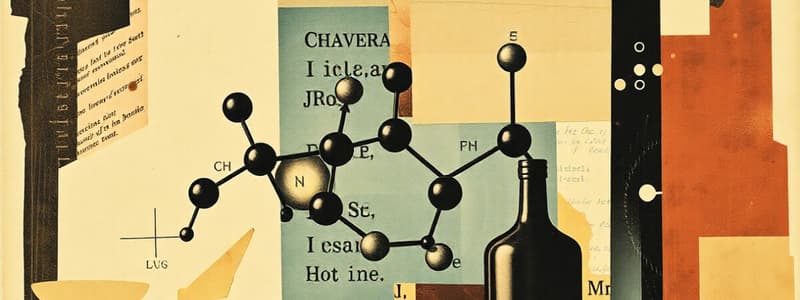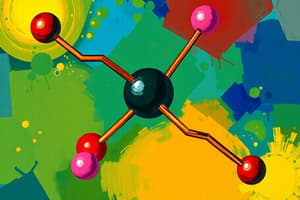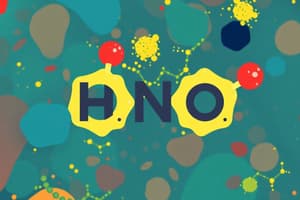Podcast
Questions and Answers
What type of hybridization do all the carbon atoms in benzene undergo?
What type of hybridization do all the carbon atoms in benzene undergo?
- sp2 hybridization (correct)
- d2sp3 hybridization
- sp3 hybridization
- sp hybridization
How many sigma (σ) bonds does each carbon atom in benzene form?
How many sigma (σ) bonds does each carbon atom in benzene form?
- Four
- One
- Two
- Three (correct)
What is the nature of the electrons involved in the π bonding system of benzene?
What is the nature of the electrons involved in the π bonding system of benzene?
- They are localized between two carbon atoms.
- They are delocalized over all six carbon atoms. (correct)
- They are fixed in position above and below the plane.
- They are tightly bound to individual carbon atoms.
What is the bond angle around each sp2 hybridized carbon atom in benzene?
What is the bond angle around each sp2 hybridized carbon atom in benzene?
Which of the following statements about π bonds in benzene is true?
Which of the following statements about π bonds in benzene is true?
What is the structural representation of phenylamine?
What is the structural representation of phenylamine?
How are the positions of substituent groups indicated when naming aryl compounds?
How are the positions of substituent groups indicated when naming aryl compounds?
Which of the following compounds is a substituted benzene?
Which of the following compounds is a substituted benzene?
What is the product formed during the sulfonation of benzene?
What is the product formed during the sulfonation of benzene?
Which molecule acts as the electrophile in the sulfonation of benzene?
Which molecule acts as the electrophile in the sulfonation of benzene?
What is the role of aluminium chloride in Friedel–Crafts reactions?
What is the role of aluminium chloride in Friedel–Crafts reactions?
What type of group is introduced into the benzene ring during Friedel-Crafts alkylation?
What type of group is introduced into the benzene ring during Friedel-Crafts alkylation?
What functional group characterizes an acyl group in Friedel-Crafts reactions?
What functional group characterizes an acyl group in Friedel-Crafts reactions?
In the mechanism of Friedel-Crafts reactions, what is the first step to generate the electrophile?
In the mechanism of Friedel-Crafts reactions, what is the first step to generate the electrophile?
What type of reaction is sulfonation considered to be?
What type of reaction is sulfonation considered to be?
Which atom in the SO3 molecule is primarily involved in accepting an electron pair during sulfonation?
Which atom in the SO3 molecule is primarily involved in accepting an electron pair during sulfonation?
What type of groups activate the positions of the benzene ring?
What type of groups activate the positions of the benzene ring?
When excess chlorine gas is used with methylbenzene, which of the following products is NOT formed?
When excess chlorine gas is used with methylbenzene, which of the following products is NOT formed?
What is the characteristic of the carbon–halogen bond in halogenoarenes?
What is the characteristic of the carbon–halogen bond in halogenoarenes?
What type of reaction occurs when chlorine reacts with alkanes in the presence of UV light?
What type of reaction occurs when chlorine reacts with alkanes in the presence of UV light?
If bromine is added to methylbenzene in the presence of aluminium bromide, what main product is expected?
If bromine is added to methylbenzene in the presence of aluminium bromide, what main product is expected?
How does the reaction of methylbenzene and bromine differ when boiled in the presence of UV light?
How does the reaction of methylbenzene and bromine differ when boiled in the presence of UV light?
What mechanism is involved in electrophilic substitution reactions of benzene?
What mechanism is involved in electrophilic substitution reactions of benzene?
Which positions in substituted arenes are considered equivalent during substitution reactions?
Which positions in substituted arenes are considered equivalent during substitution reactions?
What happens to the delocalised electrons in benzene during electrophilic substitution?
What happens to the delocalised electrons in benzene during electrophilic substitution?
How is the electrophile created in the electrophilic substitution of benzene with bromine?
How is the electrophile created in the electrophilic substitution of benzene with bromine?
Which catalysts are known as halogen carriers in benzene reactions?
Which catalysts are known as halogen carriers in benzene reactions?
What effect does an addition reaction have on the benzene ring's aromatic stabilization?
What effect does an addition reaction have on the benzene ring's aromatic stabilization?
In the electrophilic substitution mechanism, what do the curly arrows represent?
In the electrophilic substitution mechanism, what do the curly arrows represent?
When methylbenzene undergoes electrophilic substitution, where does the halogen atom typically substitute?
When methylbenzene undergoes electrophilic substitution, where does the halogen atom typically substitute?
What type of bonding is present in benzene?
What type of bonding is present in benzene?
What is the primary characteristic of the benzene ring that allows it to react with electrophiles?
What is the primary characteristic of the benzene ring that allows it to react with electrophiles?
What is the first step in the acylation of benzene?
What is the first step in the acylation of benzene?
What happens to the alkane side-chain of alkylarenes during oxidation?
What happens to the alkane side-chain of alkylarenes during oxidation?
Which catalyst is used in the hydrogenation of benzene?
Which catalyst is used in the hydrogenation of benzene?
What is the product formed when methylbenzene is hydrogenated?
What is the product formed when methylbenzene is hydrogenated?
What is the electrophile involved in the nitration process?
What is the electrophile involved in the nitration process?
What is the main purpose of the nitrating mixture of concentrated nitric acid and sulfuric acid?
What is the main purpose of the nitrating mixture of concentrated nitric acid and sulfuric acid?
What is the final step in the mechanism for alkylation of benzene?
What is the final step in the mechanism for alkylation of benzene?
In the first stage of nitration, what happens to the electron pair from the benzene ring?
In the first stage of nitration, what happens to the electron pair from the benzene ring?
What type of product is formed when benzene reacts with chloroalkanes in alkylation?
What type of product is formed when benzene reacts with chloroalkanes in alkylation?
What is produced from the oxidation of hexylbenzene using alkaline potassium manganate(VII)?
What is produced from the oxidation of hexylbenzene using alkaline potassium manganate(VII)?
What happens to the benzene ring’s electron system during nitration?
What happens to the benzene ring’s electron system during nitration?
Which reaction classifies the conversion of benzene to cyclohexane?
Which reaction classifies the conversion of benzene to cyclohexane?
Which positions on the benzene ring are preferred during further nitration of nitrobenzene?
Which positions on the benzene ring are preferred during further nitration of nitrobenzene?
What type of effect does the nitro group exhibit in the context of nitration reactions?
What type of effect does the nitro group exhibit in the context of nitration reactions?
What is formed as a by-product when nitration occurs?
What is formed as a by-product when nitration occurs?
What is the name of one of the products formed from the nitration of methylbenzene?
What is the name of one of the products formed from the nitration of methylbenzene?
Flashcards
Delocalization in benzene
Delocalization in benzene
The process in which the electrons in the π bonding system of benzene are not localized to specific carbon atoms but are spread out over all six carbon atoms.
π bonding in benzene
π bonding in benzene
Each carbon atom in benzene contributes one electron to form a π bond, which is not a localized bond between two carbon atoms like in alkenes, but is spread over all six carbon atoms.
σ bonding in benzene
σ bonding in benzene
The three σ bonds that each carbon atom forms in benzene: one with each neighboring carbon atom and one with a hydrogen atom.
Aryl compounds
Aryl compounds
Signup and view all the flashcards
Electrons in the π bonding of Benzene
Electrons in the π bonding of Benzene
Signup and view all the flashcards
Skeletal formula of Benzene
Skeletal formula of Benzene
Signup and view all the flashcards
Phenyl group
Phenyl group
Signup and view all the flashcards
Phenylamine
Phenylamine
Signup and view all the flashcards
Electrophilic Substitution
Electrophilic Substitution
Signup and view all the flashcards
Electrophile
Electrophile
Signup and view all the flashcards
Br+ Cation
Br+ Cation
Signup and view all the flashcards
Delocalized Electrons in Benzene
Delocalized Electrons in Benzene
Signup and view all the flashcards
1,3,5-Tribromobenzene
1,3,5-Tribromobenzene
Signup and view all the flashcards
1,3-Dichloro-5-nitrobenzene
1,3-Dichloro-5-nitrobenzene
Signup and view all the flashcards
Arenes
Arenes
Signup and view all the flashcards
Nitration
Nitration
Signup and view all the flashcards
Nitronium Ion
Nitronium Ion
Signup and view all the flashcards
Nitrating Mixture
Nitrating Mixture
Signup and view all the flashcards
Electrophilic Aromatic Substitution
Electrophilic Aromatic Substitution
Signup and view all the flashcards
Deactivating Effect of Nitro group
Deactivating Effect of Nitro group
Signup and view all the flashcards
Directing Effect of Substituents
Directing Effect of Substituents
Signup and view all the flashcards
Nitrobenzene
Nitrobenzene
Signup and view all the flashcards
Mono-Substituted Nitro Toluene
Mono-Substituted Nitro Toluene
Signup and view all the flashcards
Electrophilic Aromatic Halogenation
Electrophilic Aromatic Halogenation
Signup and view all the flashcards
Free Radical Halogenation of Alkyl Side Chains
Free Radical Halogenation of Alkyl Side Chains
Signup and view all the flashcards
Electron-donating group
Electron-donating group
Signup and view all the flashcards
Multi-Substitution in Benzene
Multi-Substitution in Benzene
Signup and view all the flashcards
Reactivity of Aromatic Compounds
Reactivity of Aromatic Compounds
Signup and view all the flashcards
Nitration of Benzene
Nitration of Benzene
Signup and view all the flashcards
Substitution Positions in Benzene
Substitution Positions in Benzene
Signup and view all the flashcards
Sulfonation
Sulfonation
Signup and view all the flashcards
Alkylation of Benzene (Friedel-Crafts)
Alkylation of Benzene (Friedel-Crafts)
Signup and view all the flashcards
Acylation of Benzene (Friedel-Crafts)
Acylation of Benzene (Friedel-Crafts)
Signup and view all the flashcards
Electrophile in Friedel-Crafts
Electrophile in Friedel-Crafts
Signup and view all the flashcards
Alkylation Mechanism (Friedel-Crafts)
Alkylation Mechanism (Friedel-Crafts)
Signup and view all the flashcards
Modifying Arene Structure
Modifying Arene Structure
Signup and view all the flashcards
Benzene's Reactivity
Benzene's Reactivity
Signup and view all the flashcards
Electrophile in Electrophilic Substitution
Electrophile in Electrophilic Substitution
Signup and view all the flashcards
Alkylation of benzene
Alkylation of benzene
Signup and view all the flashcards
Acylation of benzene
Acylation of benzene
Signup and view all the flashcards
Electrophile in Benzene Reactions
Electrophile in Benzene Reactions
Signup and view all the flashcards
Benzene ring in Reactions
Benzene ring in Reactions
Signup and view all the flashcards
Catalyst regeneration
Catalyst regeneration
Signup and view all the flashcards
Oxidation of alkyl side-chain
Oxidation of alkyl side-chain
Signup and view all the flashcards
Hydrogenation of benzene
Hydrogenation of benzene
Signup and view all the flashcards
Reaction type of benzene hydrogenation
Reaction type of benzene hydrogenation
Signup and view all the flashcards
Study Notes
Benzene Ring Structure and Bonding
- Benzene is a six-carbon atom ring, a crucial functional group in many organic compounds (medicines, dyes, plastics).
- Kekulé's structure initially proposed three double bonds alternating with single bonds in the ring, but this model fails to reflect benzene's symmetrical and planar structure.
- Modern understanding reveals benzene's structure as a planar hexagon with all carbon-carbon bonds equal in length. This is due to the delocalisation of π electrons, spreading above and below the plane of the ring.
- The six π electrons are delocalised, meaning they're not confined to a specific carbon-carbon bond but are shared by all six carbon atoms. Forming a continuous ring of pi bonds.
- Each carbon atom in benzene is sp² hybridised forming three σ bonds, and one unhybridized p orbital that overlaps with neighbouring carbon atoms to form the delocalized π system.
- Bond lengths in benzene are intermediate between C-C single and C=C double bonds reflecting the delocalisation of electrons within the ring. (approx. 0.139 nm for C-C bonds)
Naming Aromatic Compounds
- Aryl compounds include functional groups directly substituted onto a benzene ring, replacing a hydrogen atom.
- Different substituent groups result in different aryl compounds, with specific naming conventions.
Electrophilic Substitution in Benzene
- Benzene reacts with electrophiles, which are electron-seeking species, through electrophilic substitution reactions, maintaining the stability of the benzene ring's cyclic π bond structure.
- Examples of reactants include chlorine, bromine (with aluminium bromide as a catalyst), and the nitration mixture (nitric and sulfuric acids to produce the nitronium ion).
- The reaction with bromine or chlorine uses a catalyst, typically anhydrous AlBr3 or AlCl3, to generate the electrophile needed for the substitution reaction.
Friedel-Crafts Reactions: Alkylation and Acylation
- Friedel-Crafts reactions are electrophilic substitution reactions that add alkyl or acyl groups to a benzene ring.
- Typical alkylating agents could be a halogenoalkane and a catalyst
- Typical acylating agents could be acyl chlorides or acid anhydrides with a catalyst, both reactions proceed via a carbocation electrophile.
- The reactions proceed by forming a carbocation electrophile to attack the benzene ring.
Oxidation of Side Chains in Arenes
- Oxidation reactions of the alkyl side-chains in aryl compounds are possible, where the alkyl side-chain can be oxidized, transforming them into carboxylic acids (for example, methylbenzene oxidizing to produce benzoic acid)
Hydrogenation of Arenes
- The hydrogenation of arenes results in the conversion of the benzene ring into a saturated ring compound, in this case cyclohexane, because the hydrogen atoms bond to each carbon atom of the benzene ring to form a saturated alkane chain.
Studying That Suits You
Use AI to generate personalized quizzes and flashcards to suit your learning preferences.




